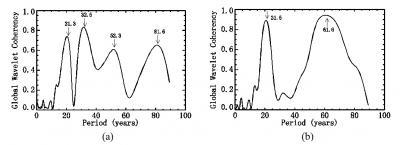We know solar cycles impact the weather and the climate but figuring how much, and how much of recent warming has been due to human-controllable variables, has been difficult.
A recent paper found the existence of significant resonance cycles and high correlations between solar activity and the Earth's averaged surface temperature during centuries.
It adopts the wavelet analysis technique and cross correlation method to investigate the periodicities of solar activity and the Earth's temperature as well as their correlations during the past centuries.

Global wavelet coherence between Sunspot number (a), Total Solar Irradiance (b) and the anomalies of the Earth's averaged surface temperature. The resonant periodicities of 21.3-year (21.5-year), 52.3-year (61.6-year), and 81.6-year are close to the 22-year, 50-year, and 100-year cycles of solar activity. Credit: ©Science China Press
Global warming is obviously the most discussed science topic in the world. It put UN science on the map, something people did not even know the UN did before media attention focused on The Intergovernmental Panel on Climate Change (IPCC), which says that the release of anthropogenic greenhouse gases contributed to 90% or more of the observed increase in the global average temperature in the past 50 years.
Other groups have found that the current warming does not exceed the natural fluctuations of climate. The authors of the new paper say that the climate models of the IPCC underestimate the impact of natural factors on the climate change and overstate that of human activities. Solar activity is an important natural driving forces of climate, so it is important to investigate the influence of solar variability on the Earth's climate change using long time scales.
The researchers combined the measured data with those reconstructed to disclose the periodicities of solar activity during centuries and their correlations with the Earth's temperature. The obtained results demonstrate that solar activity and the Earth's temperature have significant resonance cycles, and the Earth's temperature has periodic variations similar to those of solar activity.
This study also implies that the "modern maximum" of solar activity agrees well with the recent global warming of the Earth. A significant correlation between them can be found.

Comparisons between the 11-year running averaged Total Solar Irradiance (TSI) and the temperature (T) anomalies of the Earth (global, land, ocean). Credit: ©Science China Press






Comments